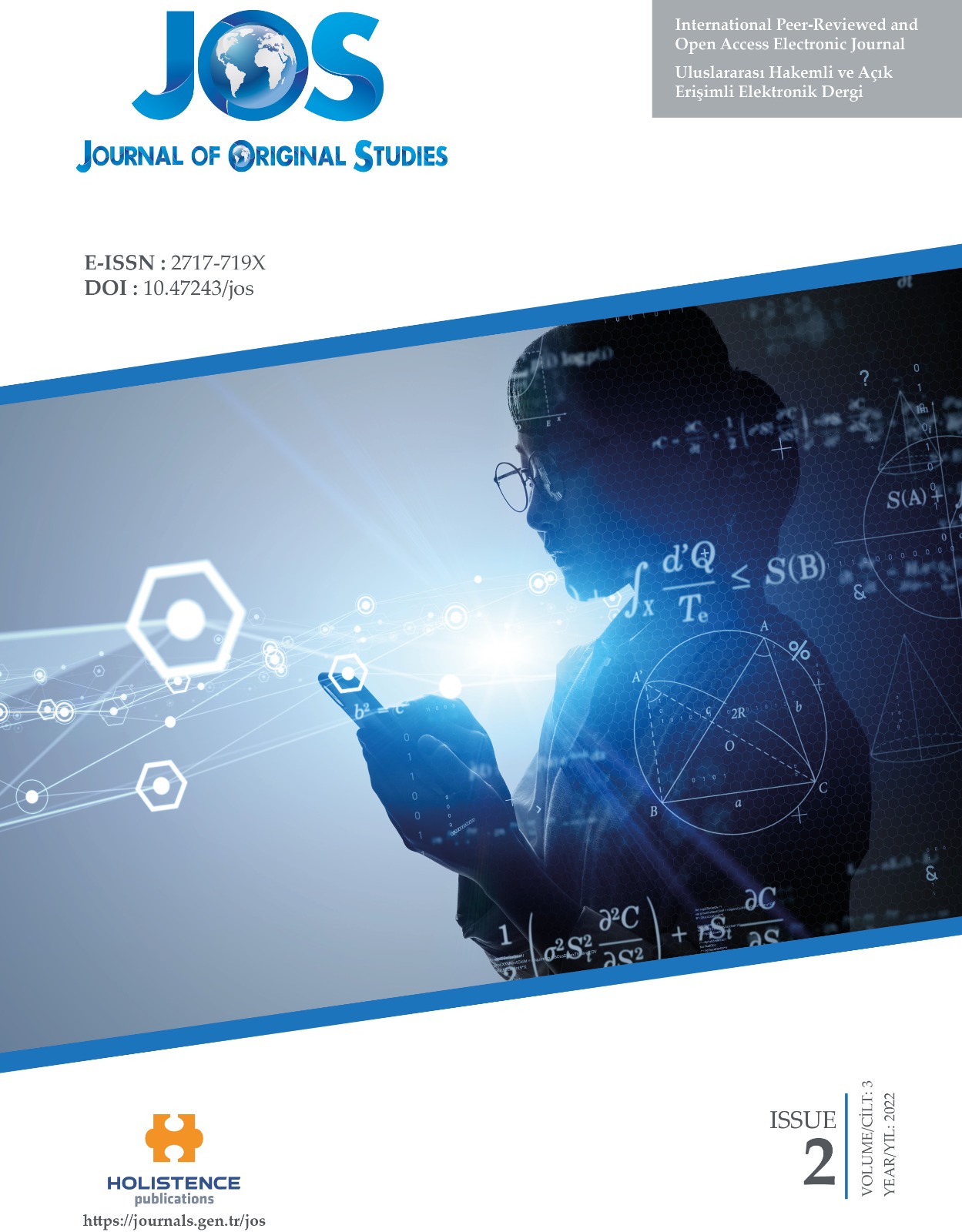Resource Diversification in Turkey’s Electricity generation
DOI:
https://doi.org/10.47243/jos.3.2.03Keywords:
Electricity Generation, Concentration, Diversification Energy Resources, Herfindahl-HirschmanAbstract
Natural gas, fuel oil, coal, lignite, geothermal, wind, solar, hydraulics, etc. are used in electricity generation, which is one of the most important inputs of industrial production. Being dependent on one or several sources of electricity generation is an important risk factor for the industry and economy of the country. A problem in the supply of one of these resources or an increase in prices may adversely affect the entire country’s industry and therefore the economy. In this research, we measured the concentration of the resources Turkey uses in electricity generation between the years 2000-2020. We used the Herfindahl-Hirschman and concentration indices. The resource concentration in Turkey’s electricity production started to decrease towards the end of the period. Reducing the use of natural gas and more use of geothermal, solar, and wind resources have been effective in this result. While Turkey produced 49.8% of its electricity production using natural gas in 2008, this rate decreased to 23.1% in 2020. While Turkey provided 95.6% of its electricity production from four sources in 2002, this rate decreased to 81.3% in 2020. These rates show that Turkey has increased diversification in electricity generation, but this diversification is still not sufficient.
Downloads
References
ALTINAY, G., & KARAGÖL, E. (2005). Electricity consumption and economic growth: evidence from Turkey. Energy economics, 27(6), 849-856.
ALTUN, Y. & İŞLEYEN, Ş. (2018). Bazı OECD Ülkelerinde Yenilenebilir Enerji Kaynaklarından Elektrik Üretimine Yönelim Üzerine Amprik Bir Çalışma. Atatürk Üniversitesi Sosyal Bilimler Enstitüsü Dergisi. 22(3). 1577-1590.
BAĞCI, E. (2019). Türkiye’de Yenilenebilir Enerji Potansiyeli, Üretimi, Tüketimi ve Cari İşlemler Dengesi, R&S-Research Studies Anatolia Journal, 2(4), 101-117
BIROL, Y. E. (2021). “Doğal Gaz Arz Güvenliği Açısından Avrupa Birliği Ülkeleri ve Türkiye Üzerine Karşılaştırmalı Bir Analiz” Pamukkale Üniversitesi Sosyal Bilimler Enstitüsü Dergisi, sayı 44, Denizli, ss. 451-467.
DILEK, S., & KONAK, A. (2022). Kuzey Afrika Ülkelerinin İthalatında Kaynak Ülke Çeşitlendirmesinin Yoğunlaşma Oranı ve HerfindahlHirschman Endeksi Aracılığıyla Ölçümü. Ekonomik ve Sosyal Araştırmalar Dergisi, 18(1), 1-16.
DILEK, S. (2017). Oyun Teorisi eşliğinde Sanayi Ekonomisi. Seçkin Yayınları.
DILEK, S., & KONAK, A. (2016). Concentration in Kastamonu Halva Production Sector Between 1994 and 2014. Procedia-Social and Behavioral Sciences, 229, 158-166.
ERDOĞAN, S., DÜCAN, E., ŞENTÜRK, M. & ŞENTÜRK, A. (2018). Türkiye’de Yenilenebilir Enerji Üretimi ve Ekonomik Büyüme İlişkisi Üzerine Amprik Bulgular. Ömer Halisdemir Üniversitesi İktisadi ve İdari Bilimler Fakültesi Dergisi. 11(2). 233-246.
GÜNGÖR, D. (2022). Çölde 12 Kilometrelik Güneş Tarlası. Sabah Gazetesi. https://www.sabah.com.tr/yazarlar/dilek-gungor/2022/08/05/colde-12- kilometrelik-gunes-tarlasi. Erişim: 01.09.2022
HALSER, C. & PARASCHIV, F. (2022). Pathways to Overcoming Natural Gas Dependency on Russia—The German Case. Energies. 15, 4939. https://doi. org/10.3390/en15144939
İNANÇLI, S. & AKI, A. (2020). Türkiye’nin Enerji İthalatı ve Yenilenebilir Enerji Arasındaki İlişkinin Ampirik Olarak İncelenmesi . Econder International Academic Journal , 4 (2) , 551-564 .
KAMACI, A. ve AKÇA, Y. (2021). TR81 Bölgesinin Yenilenebilir Enerji Durumu. Bartın Üniversitesi İktisadi ve İdari Bilimler Fakültesi Dergisi, 12 (24), 400-412
KARAGÖL, E. T., KAVAZ, İ. (2017). Dünya ve Türkiye’de Yenilenebilir Enerji, Analiz, 197, 1-31
KAYA, K., ŞENEL, M.C. & KOÇ, E., (2018). Dünyada ve Türkiye’de Yenilenebilir Enerji Kaynaklarinin Değerlendirilmesi. Technological Applied Sciences (NWSATAS), 13(3): 219-234. DOI:10.12739/NWSA.2018.13.3.2A0152
KESGINGÖZ, H., & DILEK, S. (2016). Middle Income Trap and Turkey. The Empirical Economics Letters, 15(7), 658-666.
KONAK A. (2019). Türkiye’nin doğal gaz bağımlılığı ve alternatif enerji kaynakları üretiminin gerekliliği. International Journal of Afro-Eurasian Research (ICAR), 4(7),196-209
LAMBERT, L. A., TAYAH, J., LEE-SCHMID, C., Abdalla, M., Abdallah, I., Ali, A. H., & Ahmed, W. (2022). The EU’s natural gas Cold War and diversification challenges. Energy Strategy Reviews, 43, 100934.
MOFTAH, N. A., & DILEK, S. (2021). Toda-Yamamoto causality test between energy consumption and economic growth: evidence from a panel of Middle Eastern countries. J. Empir. Econ. Soc. Sci., 3(1), 56-78.
OBADI, S.M. & KORCEK, M. (2020). Quantifying The Energy Security of Selected EU Countries. International Journal of Energy Economics and Policy. 10(2). 276-284
ODEH, R. P., & WATTS, D. (2019). Impacts of wind and solar spatial diversification on its market value: A case study of the Chilean electricity market. Renewable and Sustainable Energy Reviews, 111, 442-461.
DE ROSA, M., GAINSFORD, K., PALLONETTO, F., & FINN, D. P. (2022). Diversification, concentration and renewability of the energy supply in the European Union. Energy, 253, 124097.
RUBIO-VARAS, M., & MUÑOZ-DELGADO, B. (2019). The Energy Mix Concentration Index (EMCI): Metholodological Considerations For Implementation. MethodsX, 6, 1228-1237
SENSOY, N. (2019). Market Power Analysis for the Turkish Electricity Market. In 2019 16th International Conference on the European Energy Market (EEM) September. (pp. 1-5). IEEE.
TEIAS (2022). https://www.teias.gov.tr/Turkeyelektrik-uretim-iletim-istatistikleri Date:03.09.2022
VIVODA, V. (2019). LNG import diversification and energy security in Asia. Energy Policy, 129, 967-974.
YILMAZ, M. (2012). Türkiye’nin Enerji Potansiyeli ve Yenilenebilir Enerji Kaynaklarının Elektrik Enerjisi Üretimi Açısından Önemi. Ankara Üniversitesi Çevre Bilimleri Dergisi. 4(2). 33-54
Downloads
Published
How to Cite
Issue
Section
License
Copyright (c) 2022 Holistence Publications

This work is licensed under a Creative Commons Attribution 4.0 International License.
When the article is accepted for publication in the Journal of Orijinal Studies, authors transfer all copyright in the article to the Holistence Academy Ar-Ge Yazılım Yayıncılık Eğitim Danışmanlık ve Organizasyon Ticaret Ltd. Şti.The authors reserve all proprietary right other than copyright, such as patent rights.
Everyone who is listed as an author in this article should have made a substantial, direct, intellectual contribution to the work and should take public responsibility for it.
This paper contains works that have not previously published or not under consideration for publication in other journals.














